The time has come to finish what we started. The cider is ready to be bottled. Woo-hoo!

We used this big plastic drum to soak the bottles in a mild chlorine solution. They were then rinsed well and left to dry on the dishwasher racks.
The corn sugar starts a new fermentation, but this time inside sealed bottles. Since the carbon dioxide can't escape, the bubbles are trapped inside, and the cider is carbonated. That's science at work for you. Molecular gastronomy.

Then the brew was siffoned into bottles,
and the bottles were capped.


Before I describe the process to you, let me just mention that we did rack the cider a second time last weekend, to clear out the last of the cloudiness. The brew is now clean and lovely.
Every step in this process has started with the sterilization of the equipment, and today that included the bottles

We used this big plastic drum to soak the bottles in a mild chlorine solution. They were then rinsed well and left to dry on the dishwasher racks.
.
The next step in the process was adding some corn sugar (druvsocker, in Swedish) to the cider.

The next step in the process was adding some corn sugar (druvsocker, in Swedish) to the cider.

The corn sugar starts a new fermentation, but this time inside sealed bottles. Since the carbon dioxide can't escape, the bubbles are trapped inside, and the cider is carbonated. That's science at work for you. Molecular gastronomy.
The corn sugar solution was poured into a new (sterilized) jug, which we then racked the cider into.

Then the brew was siffoned into bottles,

and the bottles were capped.


Good thing we had all the necessary equipment laying about, from my dad's beer-making days!
And here is the result...

29 big bottles of cider! Woo-hoo!
But we STILL can't drink it. The carbonating process takes 10-14 days. Until it is finished, our cider is once again cloudy.
No worries! There will be cider on Christmas Eve! And we are now so excited about our brewing enterprises, we've decided to make beer next. Of course there won't be anything from our garden in the beer, but it will be fun just the same.
